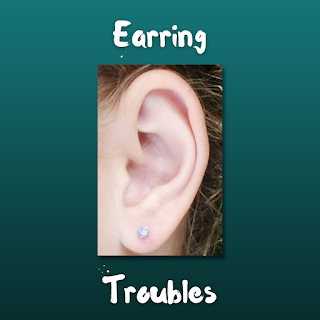In my previous post, “When to Seek Medical Care: Part 1”, I mentioned embedded foreign bodies (objects that are not part of the body that are stuck in various places inside the body). These types of situations will often require medical attention because of the various techniques and equipment required for assessment and removal. I realized that there are so many different possible objects that can be lodged in various locations in the body that this topic may require a little more explanation. So, I thought that I would address some of these situations in subsequent posts. One such situation that is not uncommon is having an earring embedded in the earlobe.
While both parts of the earring can become embedded in their respective sides of the earlobe, the most common scenario that I have seen is the main earring stud or gem being pulled in through the front of the earlobe. The earring type is usually a stud or gem that is relatively small. The larger the front of the earring, the less likely it will be pulled into the earlobe. So, in this situation, the only part of the earring that is visible is the backing. It is not too difficult to remove the earring, but pain may be the limiting factor in the removal.
Removing an earring can be painful. At best, it can be pushed back through the original hole that it backed into. At worst, an incision may be required to remove it. So, one must be prepared to use anything from no pain-relieving agent to topical or injected anesthetic agents for the patient to tolerate the procedure. Once it is determined if a pain controlling agent is required and the appropriate agent is applied or given, then the removal process can begin!
The easiest technique that I have found is to push the stud or gem back through the opening in the front of the earlobe which it was pulled into. This is accomplished by pushing the earring through frontal opening from behind the earlobe, where the backing is. However, the backing of the earring needs to be removed because it will prevent the earring from being pushed toward the front of the earlobe. So, how do you remove the backing without pulling the front of the earring further into the earlobe or causing more discomfort? The first thing that I do is place a small metal clamp (i.e., Kelly forceps) on the post/pin, just in front of the backing to stabilize the earring and prevent it from moving. Then, I take another small metal clamp and grab the backing to pull it off the post/pin. Once the backing is removed, I move the clamp that I placed on the post/pin earlier to its furthest point, away from the earlobe. Then, I use that clamp to push the earring stud or gem back through the hole in the front of the earlobe. This usually does the trick and the earring is removed! If it is the backing of the earring gets stuck behind the earlobe, I usually try to push the earring on the stud or gem side from the front of the earlobe to drive the backing back through the hole behind the earlobe. This usually works, but sometimes a small incision is required to enlarge the hole to allow the backing to pass more easily. Having a backing embedded from behind the earlobe is often more challenging to remove than the stud or gem from the front of the earlobe. But, it also seems a bit less common.
Finally, once the earring is removed, the wound needs to be cleaned with gauze and saline or water. If there is superficial irritation of the earlobe, nothing more is required. However, if the earring had been embedded for some time and the earlobe is swollen, red, more tender, or there is pus draining from the hole in the earlobe, the area is likely infected. Depending upon the severity of the infection, topical or oral antibiotics may be required to treat the earlobe infection. The timing of replacement of the earring will depend on how long it takes the earlobe to heal or treat the infection, if present. You don’t want to replace the earring too soon and have it slip back into the hole and get lodged in the earlobe again.
Well, that is my take on removing embedded earrings from the earlobe. If you have any comments, questions, or different techniques, please feel free to comment in the comment section below!


Comments
Post a Comment